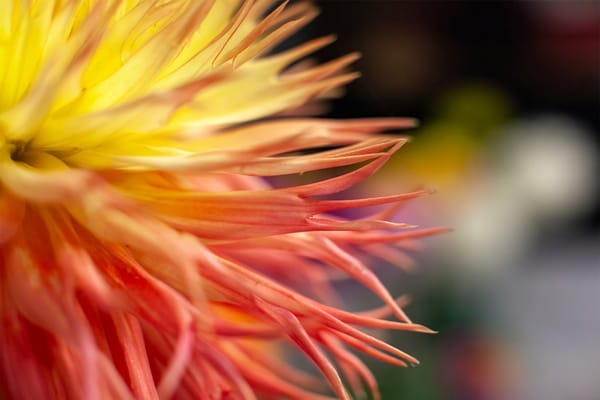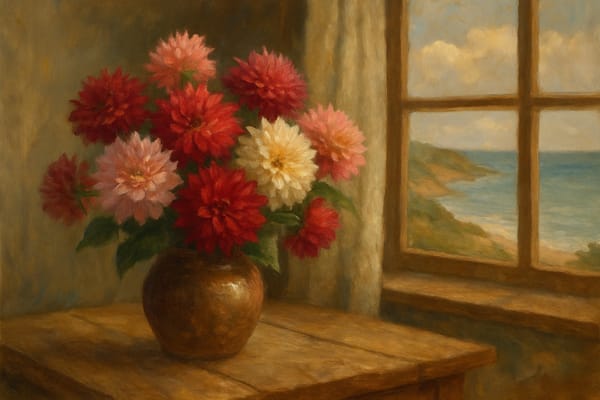In the highlands of Mexico and Central America—among pine forests and cloud-swept valleys—wild dahlias first bloomed long before they caught the eye of European gardeners. These unassuming mountain natives, known and used by the Aztecs, carried traits that would later fuel a global horticultural fascination, transforming a handful of species into the kaleidoscope of forms we know today. But beneath the dazzling display beds of modern gardens lies a story of natural resilience, cultural exchange, and the growing need for conservation.
Ancient Companions of the Highlands
Long before the name “dahlia” was coined, indigenous Mesoamerican cultures were cultivating and using wild species such as Dahlia coccinea, D. imperialis, and D. pinnata. The Aztecs prized their starchy, water-rich tubers for food and practical uses, and they fashioned hollow stems of D. imperialis—the “Tree Dahlia”—into water-carrying tubes. Far from mere ornament, dahlias were part of daily life and survival in the highland communities.
Botanists accompanying Spanish expeditions in the 16th century recorded these uses, sketching the wild forms with their scarlet, single flowers and towering, hollow stems. Yet it would take another two centuries before dahlias would cross the Atlantic for good.
The European Obsession and Hybrid Bloom
In 1789, living plant material left the Botanical Garden of Mexico City, bound for Madrid’s Royal Gardens. There, under the care of Antonio José Cavanilles, the plants flowered—and the genus Dahlia was formally named after the Swedish botanist Anders Dahl. What followed was an explosion of horticultural curiosity.
Dahlias’ natural tendency to hybridize soon became a gardener’s delight. Early introductions like D. pinnata, D. coccinea, and D. rosea produced unexpected forms and colors when grown from seed. European breeders, particularly in Spain, France, England, and the Netherlands, began crossing wild species—and hybrids among themselves—with astonishing results.
By the mid-19th century, Europe was in the grip of “dahlia mania.” Collectors and breeders generated thousands of new cultivars, selecting for size, shape, petal form, and color. The familiar decorative, cactus, pompon, and ball types—all unknown in the wild—are products of this fevered breeding era. The dahlia had been transformed from a practical highland native into a showy centerpiece of Victorian gardens.
Trade Routes and the Global Spread
The dahlia’s journey into Europe wasn’t simply botanical curiosity—it was intertwined with the colonial trade routes of the Spanish Empire. Like many New World plants, dahlias traveled alongside commodities such as cochineal dye and vanilla, often exchanged or smuggled through diplomatic and mercantile networks.
From Spain, dahlias made their way to France and England—thanks, in part, to aristocratic patrons like Lady Holland, who famously sent seeds from Madrid to Kew Gardens. Botanical gardens, nurseries, and maritime trade routes facilitated their rapid spread across Europe and, eventually, to North America and beyond.
By the 19th century, European nurseries—particularly in Holland—were exporting tubers and seeds across continents. This mass movement turned the dahlia into a garden staple, cementing its place in both private plots and grand exhibition displays.
The Wild Roots: Forgotten but Vital
Amid the rise of hybrid dahlias, the wild species that started it all faded from public view. Their direct cultivation in gardens became rare, and many pure wild lines were lost in the swirl of breeding. Yet their legacy remains critical.
Wild species such as D. coccinea (known for its bright scarlet blooms), D. juarezii (with its spiky petals), and D. imperialis (the towering tree dahlia) continue to underpin breeding efforts—providing genetic resilience, unique traits, and resistance to diseases.
But these wild populations now face mounting threats. Urban expansion, deforestation, and habitat loss in Mexico and Central America have pushed some species to the brink. Dahlia gypsicola, for example, known only from a tiny gypsum outcrop in Oaxaca, is now listed as Critically Endangered. Others, like D. calzadana and even the once-abundant D. imperialis, are increasingly at risk.
Botanical gardens, conservation institutes, and researchers are working to document and protect these wild ancestors—recognizing that their genetic diversity holds the key to the future adaptability of cultivated dahlias.
Why This Matters to Gardeners Today
For gardeners—whether in Cornwall or California—the dahlia’s story reminds us of two things: the power of plant diversity and the hidden history beneath every bloom.
- Wild species still inspire: Some specialist nurseries offer species dahlias for gardeners seeking natural beauty and pollinator-friendly plants. These can be woven into naturalistic borders or grown in wild garden corners, honoring their native resilience.
- Hybrids owe their vigor to wild genes: The strength and variety of modern cultivars come directly from the adaptability of their wild ancestors. Continued breeding success depends on conserving this genetic reservoir.
- Global journeys shape garden plants: Understanding the trade, cultural exchange, and colonial histories that brought dahlias to our borders deepens our appreciation of garden heritage—and reminds us of our role as custodians of both cultivated and wild plants.
In the Spirit of the Cornish Garden
Here in Cornwall, the dahlia feels right at home—thriving in mild coastal climates, glowing against granite walls, and lighting up borders well into autumn. Yet few realize that the flowers they admire trace a journey from Mexico’s volcanic highlands through European glasshouses, across ocean trade routes, and into our gardens.
Every tuber we plant carries echoes of mountain forests and Aztec fields, of European curiosity and horticultural passion, and of the need—now more than ever—to protect the wild roots of our cultivated favorites.











